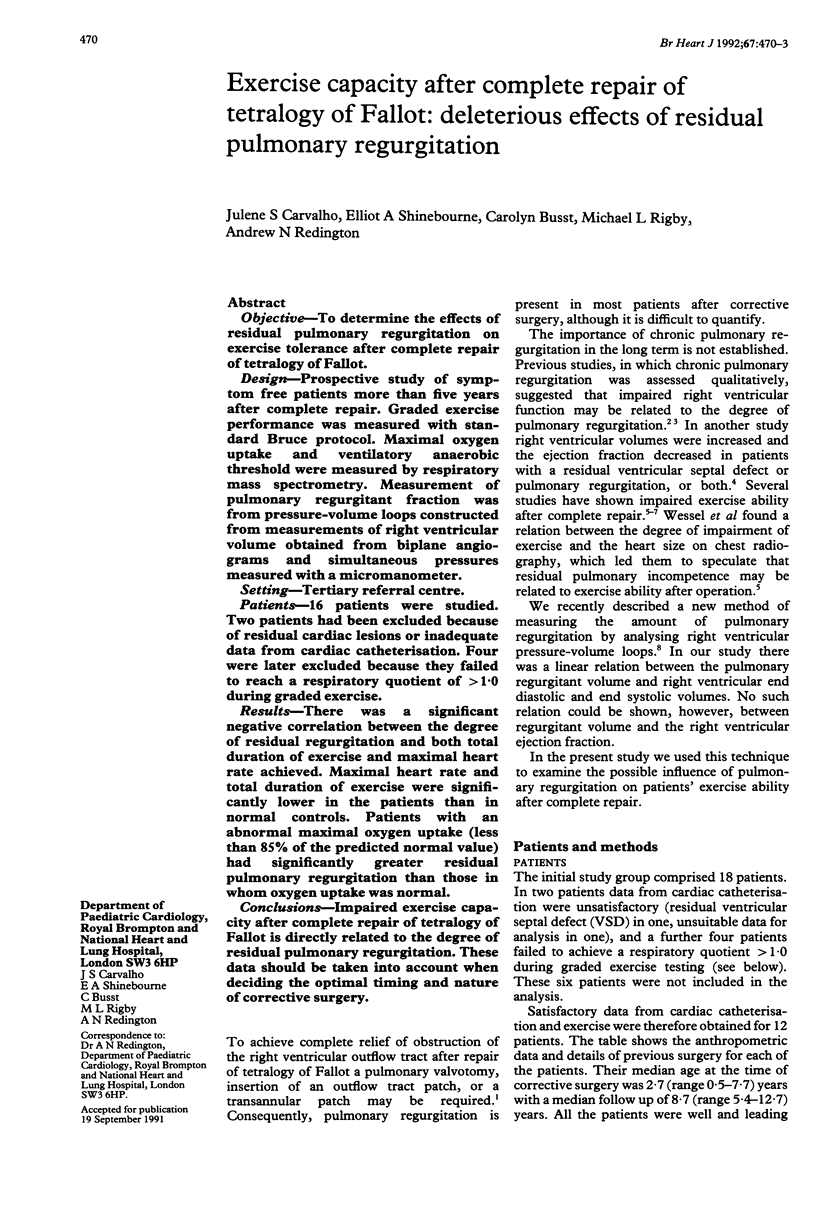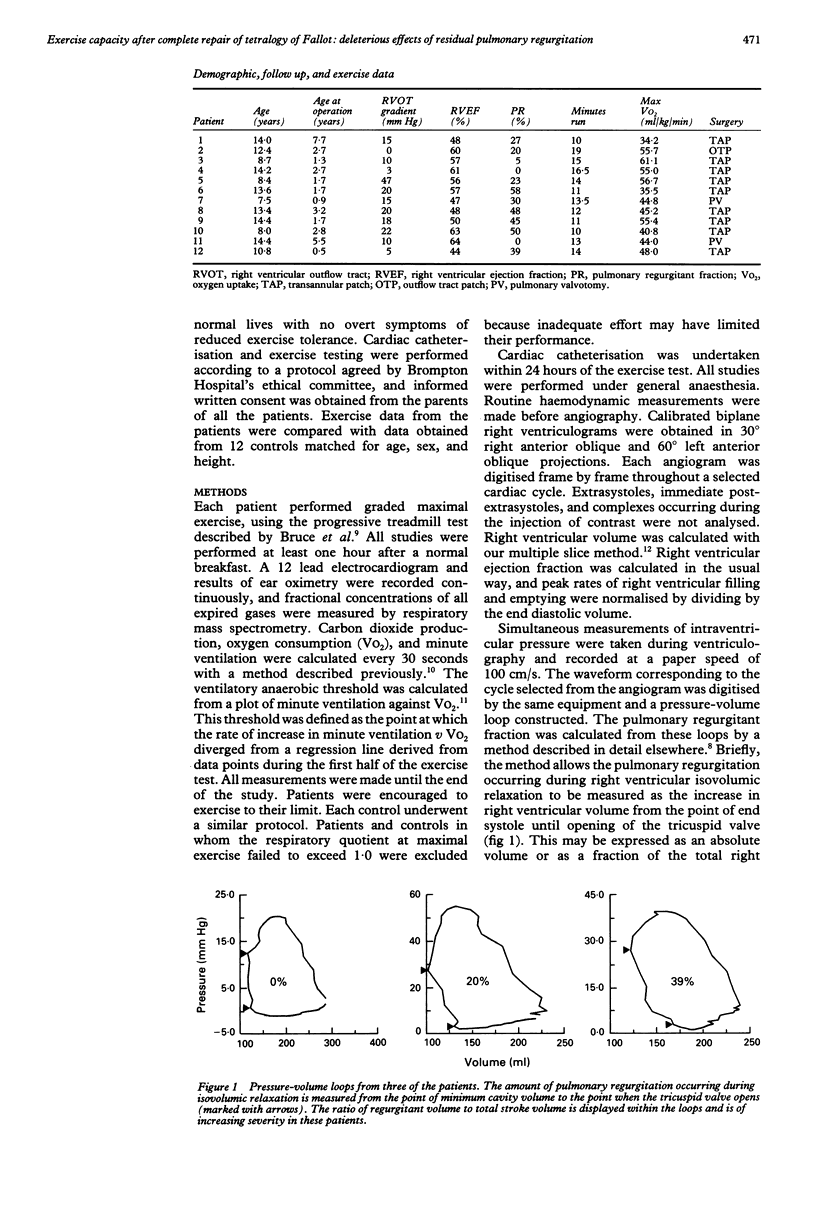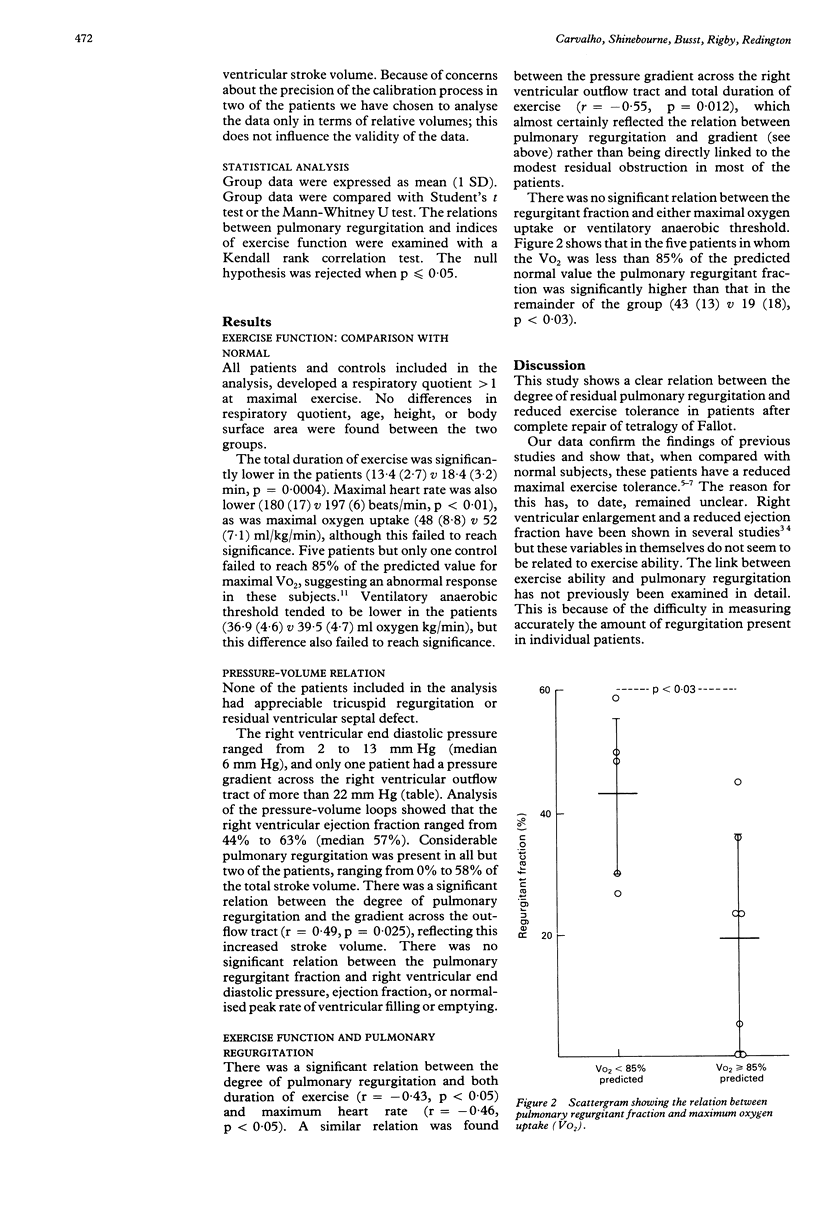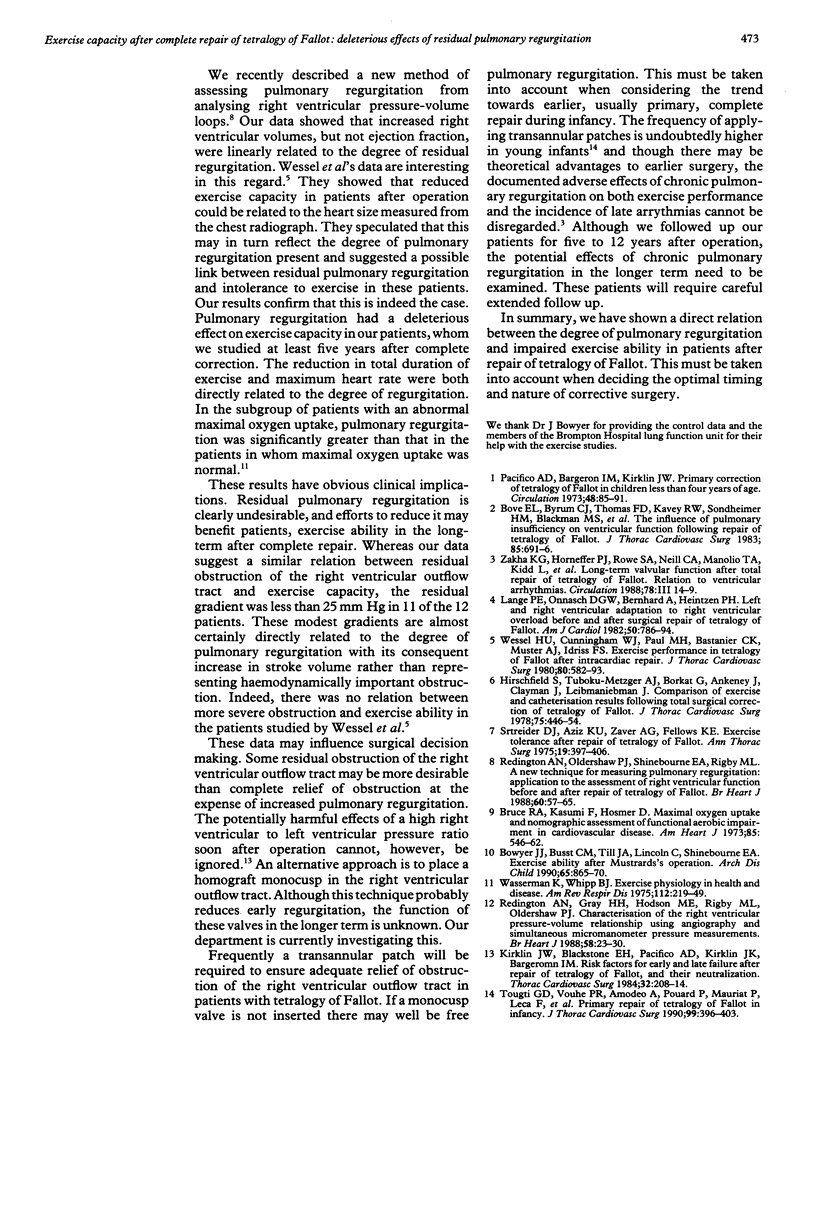Abstract
OBJECTIVE--To determine the effects of residual pulmonary regurgitation on exercise tolerance after complete repair of tetralogy of Fallot. DESIGN--Prospective study of symptom free patients more than five years after complete repair. Graded exercise performance was measured with standard Bruce protocol. Maximal oxygen uptake and ventilatory anaerobic threshold were measured by respiratory mass spectrometry. Measurement of pulmonary regurgitant fraction was from pressure-volume loops constructed from measurements of right ventricular volume obtained from biplane angiograms and simultaneous pressures measured with a micromanometer. SETTING--Tertiary referral centre. PATIENTS--16 patients were studied. Two patients had been excluded because of residual cardiac lesions or inadequate data from cardiac catheterisation. Four were later excluded because they failed to reach a respiratory quotient of greater than 1.0 during graded exercise. RESULTS--There was a significant negative correlation between the degree of residual regurgitation and both total duration of exercise and maximal heart rate achieved. Maximal heart rate and total duration of exercise were significantly lower in the patients than in normal controls. Patients with an abnormal maximal oxygen uptake (less than 85% of the predicted normal value) had significantly greater residual pulmonary regurgitation than those in whom oxygen uptake was normal. CONCLUSIONS--Impaired exercise capacity after complete repair of tetralogy of Fallot is directly related to the degree of residual pulmonary regurgitation. These data should be taken into account when deciding the optimal timing and nature of corrective surgery.
Full text
PDF



Selected References
These references are in PubMed. This may not be the complete list of references from this article.
- Bove E. L., Byrum C. J., Thomas F. D., Kavey R. E., Sondheimer H. M., Blackman M. S., Parker F. B., Jr The influence of pulmonary insufficiency on ventricular function following repair of tetralogy of Fallot. Evaluation using radionuclide ventriculography. J Thorac Cardiovasc Surg. 1983 May;85(5):691–696. [PubMed] [Google Scholar]
- Bowyer J. J., Busst C. M., Till J. A., Lincoln C., Shinebourne E. A. Exercise ability after Mustard's operation. Arch Dis Child. 1990 Aug;65(8):865–870. doi: 10.1136/adc.65.8.865. [DOI] [PMC free article] [PubMed] [Google Scholar]
- Bruce R. A., Kusumi F., Hosmer D. Maximal oxygen intake and nomographic assessment of functional aerobic impairment in cardiovascular disease. Am Heart J. 1973 Apr;85(4):546–562. doi: 10.1016/0002-8703(73)90502-4. [DOI] [PubMed] [Google Scholar]
- Hirschfeld S., Tuboku-Metzger A. J., Borkat G., Ankeney J., Clayman J., Liebman J. Comparison of exercise and catheterization results following total surgical correction of tetralogy of Fallot. J Thorac Cardiovasc Surg. 1978 Mar;75(3):446–451. [PubMed] [Google Scholar]
- Kirklin J. W., Blackstone E. H., Pacifico A. D., Kirklin J. K., Bargeron L. M., Jr Risk factors for early and late failure after repair of tetralogy of Fallot, and their neutralization. Thorac Cardiovasc Surg. 1984 Aug;32(4):208–214. doi: 10.1055/s-2007-1023386. [DOI] [PubMed] [Google Scholar]
- Lange P. E., Onnasch D. G., Bernhard A., Heintzen P. H. Left and right ventricular adaptation to right ventricular overload before and after surgical repair of tetralogy of Fallot. Am J Cardiol. 1982 Oct;50(4):786–794. doi: 10.1016/0002-9149(82)91235-8. [DOI] [PubMed] [Google Scholar]
- Redington A. N., Gray H. H., Hodson M. E., Rigby M. L., Oldershaw P. J. Characterisation of the normal right ventricular pressure-volume relation by biplane angiography and simultaneous micromanometer pressure measurements. Br Heart J. 1988 Jan;59(1):23–30. doi: 10.1136/hrt.59.1.23. [DOI] [PMC free article] [PubMed] [Google Scholar]
- Redington A. N., Oldershaw P. J., Shinebourne E. A., Rigby M. L. A new technique for the assessment of pulmonary regurgitation and its application to the assessment of right ventricular function before and after repair of tetralogy of Fallot. Br Heart J. 1988 Jul;60(1):57–65. doi: 10.1136/hrt.60.1.57. [DOI] [PMC free article] [PubMed] [Google Scholar]
- Strieder D. J., Aziz K., Zaver A. G., Fellows K. E. Exercise tolerance after repair of tetralogy of Fallot. Ann Thorac Surg. 1975 Apr;19(4):397–405. doi: 10.1016/s0003-4975(10)64041-6. [DOI] [PubMed] [Google Scholar]
- Touati G. D., Vouhé P. R., Amodeo A., Pouard P., Mauriat P., Leca F., Neveux J. Y. Primary repair of tetralogy of Fallot in infancy. J Thorac Cardiovasc Surg. 1990 Mar;99(3):396–403. [PubMed] [Google Scholar]
- Wasserman K., Whipp B. J. Excercise physiology in health and disease. Am Rev Respir Dis. 1975 Aug;112(2):219–249. doi: 10.1164/arrd.1975.112.2.219. [DOI] [PubMed] [Google Scholar]
- Wessel H. U., Cunningham W. J., Paul M. H., Bastanier C. K., Muster A. J., Idriss F. S. Exercise performance in tetralogy of Fallot after intracardiac repair. J Thorac Cardiovasc Surg. 1980 Oct;80(4):582–593. [PubMed] [Google Scholar]


